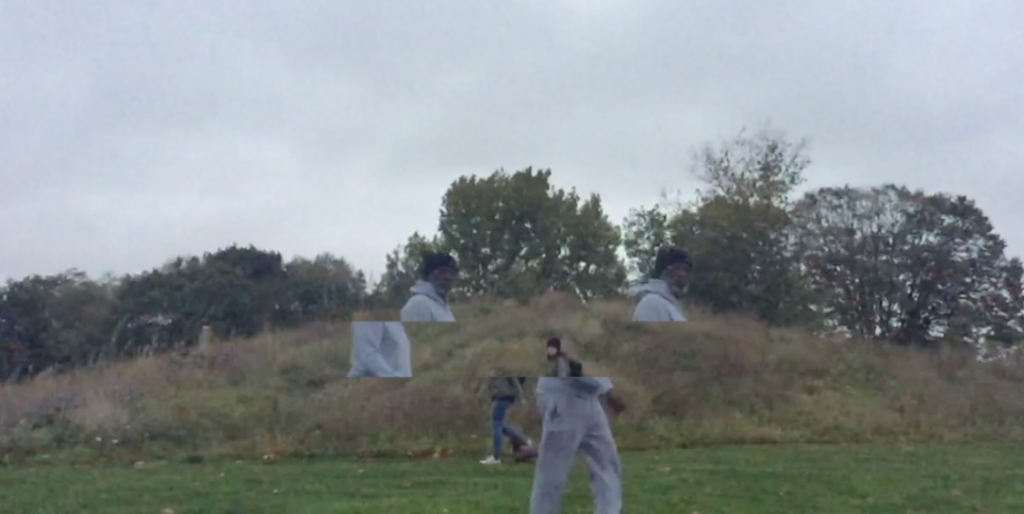I actually visited this exhibition at Sadie Coles HQ a few weeks ago, just before the course started. According to the press release, Zhongguo 2185, whose title was drawn from Liu Cixin’s 1989 ‘critical utopian’ Science Fiction novel, was “an exhibition of ten young artists from China, whose works address the shifting cultural contexts of China – past, present, and future – while also moving far beyond those social and geographical confines. The exhibition harnesses the ‘critical openness’ that early Chinese Science Fiction utilised and advocated in the face of authoritarian rule. It gestures towards potential futures while also constructing a critical vision of the past and present.” (1)
The themes of science fiction and ‘futures’ was certainly prevalent throughout the exhibition. In Occupation (2017), for example, Xu Qu uses damaged police surveillance technology (old camcorders) to construct a sculpture similar to Buddhist prayer beads. The irreversible damage to these once-cutting-edge pieces of hardware, which now sit as relics covered in a dirty resin, paired with a duo of screens nearby showing a film made completely of digitally rendered graphics, highlights the shift towards software-based, entirely digital practices are being used to make art. I understand that this wasn’t the point of the exhibition but thought it was interesting. The current growing trends towards the digital, towards 3D rendering and seemingly towards moving image are exciting, and are something that I am interested to watch progress, but sometimes I feel that they’re used just for the sake of it. Lu Yang’s digital rendering piece (pictured below right, left screen) for example seemed to just be a relentless array of low-quality, sims-like images that maybe wouldn’t be out of place if seen within a meme format found on 4chan or Facebook’s ‘Vaporwave Sadposting’ page. I have a feeling that this type of rendered image, because of how new it is as a usable technology, how ‘out of place’ it feels in a gallery space and yet how familiar it is to millennials who’ve grown up to link nostalgia with poor quality video-game graphics, will be the new ‘one-liner’ art of this generation. I don’t hate it by any means, and am even interested in incorporating it into my own work as I feel it’s a new form of painting. I’m just conscious that it could become a gimmick.
 (2)
(2)
Other works in the exhibition included the giant inflatable head, also by Lu Yang, which due to its size unavoidably became the centrepiece of the exhibition. I did think this was interesting as it provided an example of how to make the digital image tangible in a very in-your-face way, through scale (obviously) and the integration of hardware (the lights in the eyes).

There was also a large wall-based painting next to this head that caught my eye, which I actually hated. However, what drew my attention was the way in which it had been fixed to the wall.
 (3)
(3)
Instead of regularly placed fixings along the perimeters of the painting, it had instead been stabbed in random areas along the course of the piece by large metal cylinders, possibly magnets. This elevated the work somewhat for me, and although I don’t know the context for or understand this decision fully, it added a weirdly sculptural element to the piece, became an integral part of it aesthetically as well as functionally.
From a technical viewpoint, I also really enjoyed Tang Dixin’s paintings, although I thought that they became a bit lost within the ‘louder’ and more technology-driven pieces in the space. His paintings jump between the recognisable and surreal, layering and multiplying figures and limbs until a nightmarish creature is created.




After a quick look through ‘Itchy All over’, a book comprising of almost all his work, I also learnt that he does a lot of performance work, such as ‘Floating’, ‘I Will Be Back Soon’ and ‘Act of God’ (documented below).
 (4)
(4)
Tang Dixin, Floating, 2009, Performance
 (5)
(5)
Tang Dixin, I will be back soon, 2009, Performance
 (6)
(6)
Tang Dixin, Act of God, 2012, Event
According to Aike Dellarco Gallery, “Tang Dixin’s paintings, as much as his live performances, are filled with radical and extreme tensions, bringing alive the same sense of absurdity and wildness that inform his performances. His paintings evoke situations that lie between the realms of possibility and impossibility, and probably constitute a different platform for the artist to stage ‘fictional performances’ that challenge the laws of physics. Tang Dixin’s performance art and paintings mirror each other – though the two are directly opposed, they rely on and refer to each other. The artist’s physical body is what links the two halves – a concrete form imbued with abstraction.” (7) The idea of using paintings to stage performances that bypass the laws of physics is a way of looking at it that I’ve never come across before, but I suppose maybe it should have been obvious.
(Personal reference) The artists featured in Zhongguo 2185 are Lu Yang (born 1984, Shanghai, China), Tianzhuo Chen (born 1985, lives and works in Beijing, China), Yu Ji (born in Shanghai, 1985, lives and works in Shanghai), Zhang Ruyi (born 1985, Shanghai), Sun Xun (born 1980, lives and works in Beijing), Nabuqi (born 1984, Inner Mongolia, China), Chen Zhe (born 1989, Beijing, China), Xu Qu (born 1978, Jiangsu, China), Tang Dixin (born 1982, Hangzhou, China), and Lu Pingyuan, (born 1984, Zhejiang province, China) (8)
(1) (8) Sadie Coles Press release for ‘Zhongguo 2185’, 2017
http://www.sadiecoles.com/exhibitions-press-release/zhongguo-2185-curated-by-victor-wang
(2) Photographer Unknown, Installation View, 2017 – 2/10, 2017, Sadie Coles HQ
http://www.sadiecoles.com/other-exhibitions/zhongguo-2185
(3) Robert Glowacki, Installation View, 2017 – 4/10, 2017, Sadie Coles HQ
http://www.sadiecoles.com/other-exhibitions/zhongguo-2185
(4-6) Aike Dellarco Gallery, Tang Dixin, Selected Works, Photographer(s) Unknown
http://www.aikedellarco.com/artist.php?go=back&id=507
(7) Aike Dellarco Gallery, Tang Dixin, Introduction, Author Unknown
http://www.aikedellarco.com/artist.php?go=back&id=507
